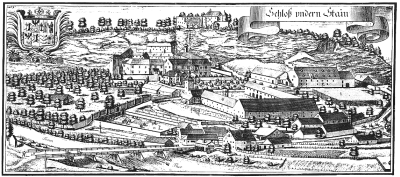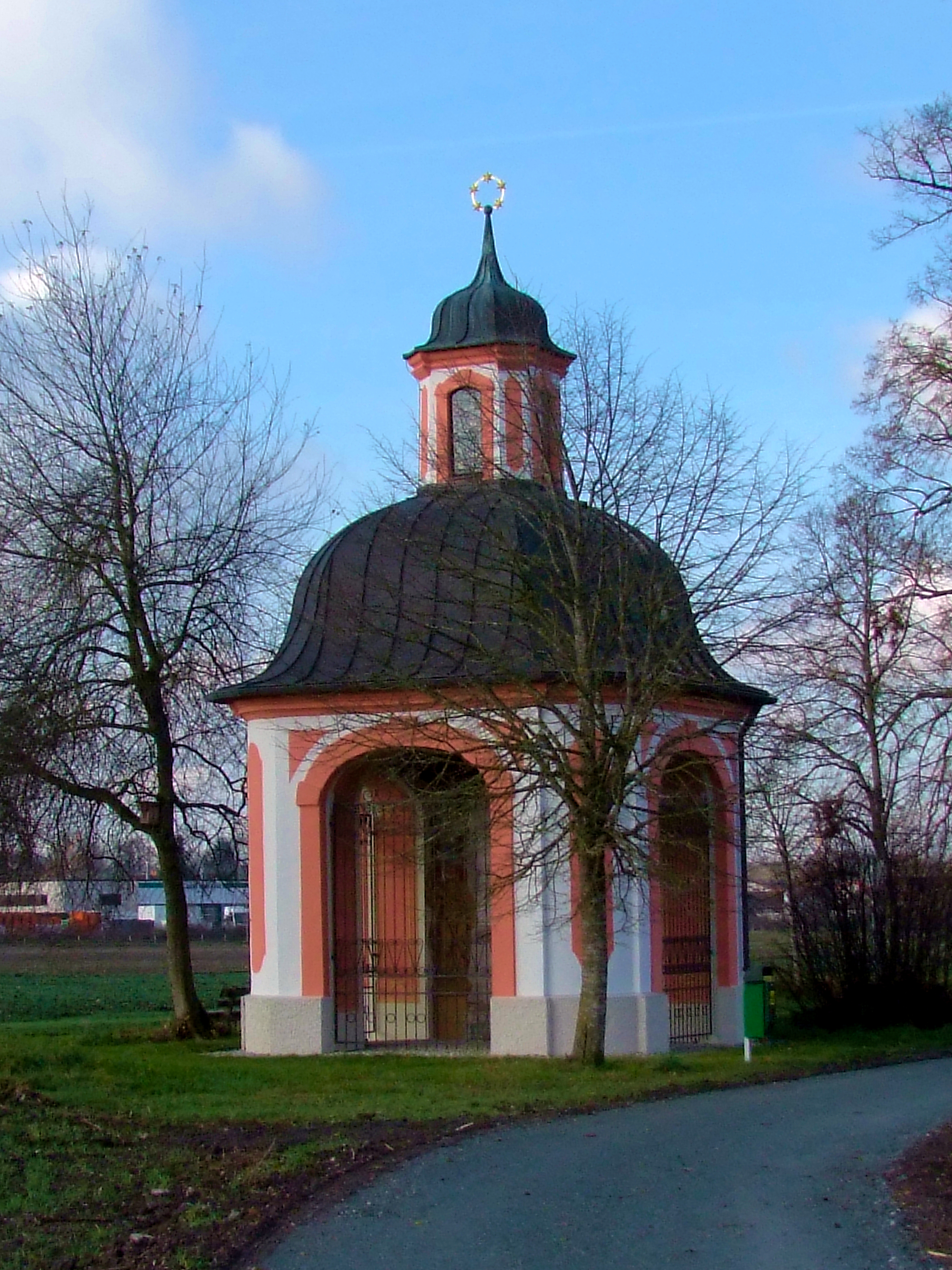|
Stein Castle (Bavaria)
Stein Castle (german: Schloss Stein) in Stein an der Traun is the most important cave castle in Germany. The castle comprises three elements: * the upper house on the almost 50 metre high steeply sloping ''nagelfluh'' rock face; * the cave castle beneath it, which hides a passage to the Traun valley in the rock; * the lower house in Stein itself. History The origins of the upper house are not totally clear. It may have stemmed from a fortification dating to the Roman or Celtic period. Stein was first recorded in 1135. The romantic figure of the legendary robber knight, Hainz von Stein dem Wilden, is closely associated with the castle. He is supposed to have lived in the castle in the early 13th century and was written about for the first time by Lorenz Huebner in 1783 in a "tragic drama about the fatherland". The castle itself was in the possession of the Toerring family from the 13th century to 1633 . Albert von Toerring-Stein was the Bishop of Regensburg from 1613 to 16 ... [...More Info...] [...Related Items...] OR: [Wikipedia] [Google] [Baidu] |
Stein An Der Traun
Traunreut (; Central Bavarian: ''Traunreit'') is a town in southeastern Bavaria, Germany in the Traunstein district. It is located at . Traunreut lies in the heart of the Chiemgau region between Munich and Salzburg, approximately 10 km east of the Chiemsee, 25 km north of the Alps, and 35 km west of Salzburg. Its population is approximately 21,000. Companies present in the area include Siteco Beleuchtungstechnik GmbH (lighting fixtures), Dr. Johannes Heidenhain GmbH (linear and rotary encoders, gaging systems, CNC controls), Bosch and Siemens Household Appliances, BSH (household equipment, high-tech stoves and microwaves), and other midsize firms. History In 1938 an ordnance factory, known as "MUNA St. Georgen", was built on the outskirts of the village of St. Georgen, at the present location of Traunreut. After World War II, with the factory closed, ethnic German expellees from their settlements in Central and Eastern Europe settled in the abandoned grounds, ... [...More Info...] [...Related Items...] OR: [Wikipedia] [Google] [Baidu] |
Cave Castle
A cave castle (german: Höhlenburg) or grotto castle (German: ''Grottenburg'') is a residential or refuge castle that has been built into a natural cave. It falls within the category of hill castles. Unlike other types (such as water castles), such castles can only be assaulted from the front, or by drilling through the rock above; the gateway is usually located in the middle of a rock face, which makes it much more difficult to penetrate. Archaeological discoveries have revealed that caves were used as places of refuge as early as the Stone Age. The first medieval cave castles emerged in the 11th and 12th centuries. In the 14th and 15th centuries this type became more widespread, especially in certain parts of France and Switzerland. Location and layout The actual cave castle was generally built at the foot of a high rock face and at the level of one or more steep scree slopes; they are however quite rare in mountainous regions, for example in North Tyrol only four sites are k ... [...More Info...] [...Related Items...] OR: [Wikipedia] [Google] [Baidu] |
Germany
Germany,, officially the Federal Republic of Germany, is a country in Central Europe. It is the second most populous country in Europe after Russia, and the most populous member state of the European Union. Germany is situated between the Baltic and North seas to the north, and the Alps to the south; it covers an area of , with a population of almost 84 million within its 16 constituent states. Germany borders Denmark to the north, Poland and the Czech Republic to the east, Austria and Switzerland to the south, and France, Luxembourg, Belgium, and the Netherlands to the west. The nation's capital and most populous city is Berlin and its financial centre is Frankfurt; the largest urban area is the Ruhr. Various Germanic tribes have inhabited the northern parts of modern Germany since classical antiquity. A region named Germania was documented before AD 100. In 962, the Kingdom of Germany formed the bulk of the Holy Roman Empire. During the 16th ce ... [...More Info...] [...Related Items...] OR: [Wikipedia] [Google] [Baidu] |
Nagelfluh
Conglomerate () is a clastic sedimentary rock that is composed of a substantial fraction of rounded to subangular gravel-size clasts. A conglomerate typically contains a matrix of finer-grained sediments, such as sand, silt, or clay, which fills the interstices between the clasts. The clasts and matrix are typically cemented by calcium carbonate, iron oxide, silica, or hardened clay. Conglomerates form by the consolidation and lithification of gravel. They can be found in sedimentary rock sequences of all ages but probably make up less than 1 percent by weight of all sedimentary rocks. In terms of origin and depositional mechanisms, they are closely related to sandstones and exhibit many of the same types of sedimentary structures, e.g., tabular and trough cross-bedding and graded bedding.Boggs, S. (2006) ''Principles of Sedimentology and Stratigraphy.'', 2nd ed. Prentice Hall, New York. 662 pp. Friedman, G.M. (2003) ''Classification of sediments and sedimentary rocks.'' In Ge ... [...More Info...] [...Related Items...] OR: [Wikipedia] [Google] [Baidu] |
Albert Von Toerring-Stein
Albert may refer to: Companies * Albert (supermarket), a supermarket chain in the Czech Republic * Albert Heijn, a supermarket chain in the Netherlands * Albert Market, a street market in The Gambia * Albert Productions, a record label * Albert Computers, Inc., a computer manufacturer in the 1980s Entertainment * ''Albert'' (1985 film), a Czechoslovak film directed by František Vláčil * ''Albert'' (2015 film), a film by Karsten Kiilerich * ''Albert'' (2016 film), an American TV movie * ''Albert'' (Ed Hall album), 1988 * "Albert" (short story), by Leo Tolstoy * Albert (comics), a character in Marvel Comics * Albert (''Discworld''), a character in Terry Pratchett's ''Discworld'' series * Albert, a character in Dario Argento's 1977 film ''Suspiria'' Military * Battle of Albert (1914), a WWI battle at Albert, Somme, France * Battle of Albert (1916), a WWI battle at Albert, Somme, France * Battle of Albert (1918), a WWI battle at Albert, Somme, France People * Albert (given n ... [...More Info...] [...Related Items...] OR: [Wikipedia] [Google] [Baidu] |
Bishop Of Regensburg
The Bishops of Regensburg (Ratisbon) are bishops of the Roman Catholic Diocese of Regensburg, Bavaria, Germany."Diocese of Regensburg" ''''. David M. Cheney. Retrieved February 29, 2016"Diocese of Regensburg" ''GCatholic.org''. Gabriel Chow. Retrieved February 29, 2016 The seat of the bishops is . History Th ...[...More Info...] [...Related Items...] OR: [Wikipedia] [Google] [Baidu] |
Adam Lorenz Von Toerring-Stein
Adam; el, Ἀδάμ, Adám; la, Adam is the name given in Genesis 1-5 to the first human. Beyond its use as the name of the first man, ''adam'' is also used in the Bible as a pronoun, individually as "a human" and in a collective sense as "mankind". tells of God's creation of the world and its creatures, including ''adam'', meaning humankind; in God forms "Adam", this time meaning a single male human, out of "the dust of the ground", places him in the Garden of Eden, and forms a woman, Eve, as his helpmate; in Adam and Eve eat the fruit of the tree of knowledge and God condemns Adam to labour on the earth for his food and to return to it on his death; deals with the birth of Adam's sons, and lists his descendants from Seth to Noah. The Genesis creation myth was adopted by both Christianity and Islam, and the name of Adam accordingly appears in the Christian scriptures and in the Quran. He also features in subsequent folkloric and mystical elaborations in later Judaism, ... [...More Info...] [...Related Items...] OR: [Wikipedia] [Google] [Baidu] |
Bavaria
Bavaria ( ; ), officially the Free State of Bavaria (german: Freistaat Bayern, link=no ), is a state in the south-east of Germany. With an area of , Bavaria is the largest German state by land area, comprising roughly a fifth of the total land area of Germany. With over 13 million inhabitants, it is second in population only to North Rhine-Westphalia, but due to its large size its population density is below the German average. Bavaria's main cities are Munich (its capital and largest city and also the third largest city in Germany), Nuremberg, and Augsburg. The history of Bavaria includes its earliest settlement by Iron Age Celtic tribes, followed by the conquests of the Roman Empire in the 1st century BC, when the territory was incorporated into the provinces of Raetia and Noricum. It became the Duchy of Bavaria (a stem duchy) in the 6th century AD following the collapse of the Western Roman Empire. It was later incorporated into the Holy Roman Empire, became an ind ... [...More Info...] [...Related Items...] OR: [Wikipedia] [Google] [Baidu] |




